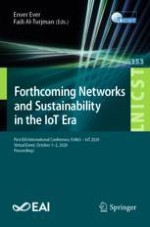2021 | Book
Forthcoming Networks and Sustainability in the IoT Era
First EAI International Conference, FoNeS – IoT 2020, Virtual Event, October 1-2, 2020, Proceedings
Editors: Dr. Enver Ever, Dr. Fadi Al-Turjman
Publisher: Springer International Publishing
Book Series : Lecture Notes of the Institute for Computer Sciences, Social Informatics and Telecommunications Engineering
